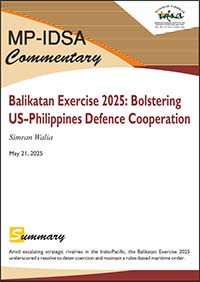Balikatan Exercise 2025: Bolstering US–Philippines Defence Cooperation
- May 21, 2025 |
- IDSA Comments
Introduction
The 40th edition of the Balikatan Exercise, the bilateral training exercise between the United States (US) military and the Philippines Armed Forces (AFP), was held from 21 April to 9 May 2025.[1] The exercise involved almost 14,000 troops—5,000 from the AFP and 9,000 from the US.[2] This year’s exercise strengthened the US–Philippines Mutual Defense Treaty of 1951 by enhancing military preparedness and interoperability. The Australian Defence Force and, for the first time, the Japan Self-Defense Force (JSDF) participated in this exercise.
The 2025 exercise occurred amid escalating regional tensions, particularly concerning China’s expansionist behaviour in the South China Sea (SCS) and its increasing military activities near Taiwan. These developments have heightened security concerns for the Philippines, prompting a focus on enhancing defence capabilities and interoperability with allied forces.
The US and the Philippines have maintained a complex security partnership since the two countries signed the Mutual Defense Treaty in 1951.[3] During a period of tensions over maritime sovereignty and persistent worry about militant forces in the Philippines, the US military offers crucial security. Additionally, the partnership gives the US a footing to better advance peace and security in an area that is becoming more unstable.
During the Cold War, the US–Philippines alliance waned as the US forces left the country and the Philippine Senate rejected a renewal of the 1947 Military Bases Agreement in 1991. To facilitate interactions between the Philippine and the US armed forces within the nation, a Visiting Forces Agreement (VFA) was reached in 1997 of which the Balikatan Exercise is also a part. The partnership between the two countries also reached a low point when President Rodrigo Duterte’s administration was against the alliance, threatened to cancel the VFA, and courted closer ties with China. However, despite the rhetoric, military cooperation between the two countries has continued.
Both nations have further stepped up their attempts to align their security postures since the Enhanced Security Cooperation Agreement (EDCA) signed in 2014 restored joint patrols and improved military basing agreements.[4] Through the EDCA, the US was able to provide funds for the construction and renovation of facilities within the Philippine military bases as well as for the rotating deployment of more American troops. Since the inception of EDCA in 2014, the US Department of Defense has allocated over US$ 100 million for infrastructure projects at EDCA sites.[5]
To bring greater focus to priority areas of defence cooperation, the US and the Philippines developed the Bilateral Defense Guidelines in 2023.[6] The guidelines were established to modernise and strengthen the alliance in response to evolving security challenges in the Indo-Pacific region. These guidelines aimed to enhance interoperability, address both conventional and non-conventional threats, and reaffirmed mutual defence commitments under the 1951 US–Philippines Mutual Defense Treaty.
The Full Battle Test, which combined actual forces and events into a simulated, scenario-based virtual exercise, was one of the noteworthy aspects of this year’s Balikatan Exercise.[7] The exercise evaluated the interoperability of US and Philippine forces in all domains—air, sea, land space, cyber and space—to simulate the defence of Philippine sovereignty.
The US made its first operational integration and deployment of its Navy-Marine Expeditionary Ship Interdiction System (NMESIS) in the Philippines during this year’s exercise. The ROGUE-Fires autonomous ground vehicle, mounted on a Joint Light Tactical Vehicle (JLTV) chassis, is integrated with Naval Strike Missiles (NSM) in this mobile, land-based anti-ship missile launcher system. The Indo-Pacific security architecture gains a new layer of deterrence with this significant improvement in coastal defence capabilities.
Along with this, the exercise consisted of four main components—a multilateral Maritime Exercise (MME), a Command-and-Control exercise (C2X), humanitarian civic aid (HCA) activities, and a Combined Joint Logistics Over-the-Shore (CJLOTS) operation. Furthermore, the Typhon missile system, also known as the Mid-Range Capability (MRC), which enables land-based launch capabilities for Tomahawk and SM-6 missiles, was also a part of the exercise.[8] With ranges of up to 1,500 kilometres, Typhon can target China’s growing A2/AD networks in the area.[9]
The deployment of US Army intermediate-range missile units, combined naval and amphibious exercises, and procurement of military hardware from the US are all examples of US–Philippines defence cooperation. As part of the fiscal year 2024 and the Indo-Pacific Security Supplemental Appropriations Act, the US recently provided the Philippines with US$ 500 million in Foreign Military Financing (FMF).[10] A US$ 5.58 billion arms package agreed by the US in April 2025 would give the Philippines up to 20 cutting-edge F-16 Block 70/72 fighter jets.[11] Through the incorporation of anti-ship missiles, these advanced aircraft significantly enhance Manila’s maritime surveillance, precision attack and anti-access capabilities.
Balikatan exercise helped the Philippine forces, particularly those in the northern and western theatre commands, to practice air-ground coordination, maritime denial operations, and fast deployment in intricate situations that closely resemble real-world threats. According to Washington, the exercise demonstrated its continued dedication to Indo-Pacific security and the formal treaty-mandated protection of allies. It also showed a proactive approach meant to discourage unilateral, drastic changes to the status quo in the region. The deployment of cutting-edge systems like NMESIS and Typhon showed a change in US strategy towards the use of mobile, precision-guided and survivable capabilities on allied territory as part of the “stand-in force” concept promoted by the US Marine Corps and the Army’s Multi-Domain Task Force.[12]
Moving Forward
Balikatan 2025 demonstrated a significant shift from purely bilateral training between the two nations to a more integrated exercise. Notably, Australia and Japan participated as full-fledged partners, reflecting deepening regional defence cooperation. Australia deployed combat troops, underscoring its operational commitment, while Japan contributed assets from both its Ground Self-Defense Force (GSDF) and Maritime Self-Defense Force (MSDF), marking a more assertive role within the Indo-Pacific security framework. This growing mini-lateral structure reflects the US intentions to strengthen its alliances under its Indo-Pacific Strategy and the Philippines’ aspirations to become a resolute security actor in the region.
In the Western Pacific, the Philippines is a significant ally of the US. In response to the Chinese threat, Japan and Australia both are reorganising their armed forces and updating their air and sea capabilities. Japan plans to raise its defence expenditure to 2 per cent of GDP by 2027. This will enable it to field a force equipped with cutting-edge fighter aircraft, highly effective navy vessels, and a variety of surface-to-air missiles, anti-ship missiles, coastal defence missiles and land-attack cruise missiles. Australia is also spending money on fast-attack submarines. Exercises like Balikatan 2025 will provide a more credible deterrent posture in addition to providing the Philippine military with operational expertise and experience in collaborating with regional partners during military operations.
Balikatan 2025 has a lot of geopolitical significance at a time when Beijing is still establishing broad maritime claims, carrying out coercive grey-zone activities, and constructing dual-use infrastructure across disputed islands and reefs. The exercise served as a platform for operational readiness and as deterrent messaging, showcasing the ability of the US and its allies to conduct coordinated, multi-domain operations in defence of shared security objectives. This year’s exercise signifies more than just enhanced military readiness and serves as a strong reaffirmation of the participating nations’ shared commitment to uphold international law and preserve regional stability. In March 2025, the US Defense Secretary Pete Hegseth had visited Manila and reaffirmed Washington’s “ironclad commitment” to the Philippines.[13] Amid escalating strategic rivalries in the Indo-Pacific, the Balikatan exercise underscored a collective resolve to deter coercion and maintain a rules-based maritime order.
Views expressed are of the author and do not necessarily reflect the views of the Manohar Parrikar IDSA or of the Government of India.
[1]“U.S. Deploying Advanced Capabilities, Concepts to Philippines for Balikatan 2025”, Indo-Pacific Defense Forum, 14 April 2025.
[2] Ibid.
[3] Gregory B. Poling, “The Transformation of the U.S.-Philippines Alliance”, Center for Strategic and International Studies (CSIS), 2 February 2023.
[4] Mico A. Galang, “A Decade On: EDCA and the Philippines–US Alliance”, RUSI, 18 April 2024.
[5] Jon Viktor D. Cabuenas, “Biden Seeks Additional $128M for EDCA Sites Projects”, GMA News Online, 13 April 2024.
[6] “Fact Sheet: US-Philippines Bilateral Defense Guidelines”, US Department of Defense, 3 May 2023.
[7] Mina Pollmann, “US, Philippines Begin Balikatan Annual Drills With South China Sea in Mind”, The Diplomat, 22 April 2025.
[8] “The U.S. Army’s Typhon Mid-Range Capability (MRC) System”, Congressional Research Service, 22 April 2025.
[9] Ibid.
[10] Wilson Beaver and Robert Peters, “Strengthening the U.S.–Philippine Alliance”, The Heritage Foundation, 19 November 2024.
[11] Leilani Chavez, “US Approves Sale of F-16s to the Philippines in $5.5bn Weapons Package”, Defense News, 2 April 2025.
[12] “U.S. Deploying Advanced Capabilities, Concepts to Philippines for Balikatan 2025”, no. 1.
[13] “US Defence Secretary Hegseth Reaffirms ‘Ironclad Commitment’ to the Philippines”, The Straits Times, 28 March 2025.
Keywords : Defence Cooperation, Military Cooperation, Philippines, United States of America (USA)





